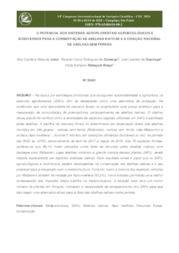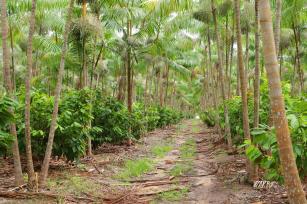Publicações
O potencial dos sistemas agroflorestais agroecológicos e biodiversos para a conservação de abelhas nativas e a criação racional de abelhas sem ferrão.
Autoria: LIMA, A. C. V. de; CAMARGO, R. C. R. de; QUEIROGA, J. L. de; MALAGODI-BRAGA, K. S.
Resumo: Resumo: Na busca por estratégias produtivas que assegurem sustentabilidade à agricultura, os sistemas agroflorestais (SAFs) vêm se destacando como uma alterna de produção. Há evidências que uma diversidade de recursos florais na propriedade rural possa contribuir para a manutenção de comunidades de polinizadores, particularmente, de abelhas nativas. O objetivo desse estudo foi verificar como a diversidade de espécies vegetais utilizadas em SAFs é partilhada pelas abelhas. A partilha de recursos florais foi determinada por observação direta das abelhas reunidas em três grupos - nativas sem ferrão (Meliponini), nativas com ferrão (não exótica (Apis mellifera) -, durante 5 minutos, em condições climáticas favoráveis ao voo, no período das 8h20 às 12h50, semanalmente de abril de 2017 a março de 2018. Das 76 espécies floridas, verificou-se que 96,1% foram utilizadas como fonte de recursos pelas abelhas nativas, com destaque para Meliponini, cujas abelhas visitaram a grande maioria dessas plantas (84%), sendo metade representada por espécies arbóreas nativas. Esse resultado revela o papel que os SAFs, agroecológicos e biodiversos, podem desempenhar na potencial para a integração com a meliponicultura. Contudo, como a maioria das espécies visitadas por Meliponini também foi visitada por Apis mellifera (63,2%), novos estudos permitirão uma melhor compreensão dos impactos dessa partilha na meliponicultura. A estação seca teve um menor número de plantas em floração, indicando a necessidade de enriquecimento dos SAFs para que eles sejam uma alternativa eficaz para a dieta das abelhas nativas neste período. -- Abstract: In the search for productive strategies that ensure sustainability for agriculture, agroforestry systems (AFS) have been standing out as a production alternative. There is evidence that the diversity of floral resources on the rural property may contribute to the maintenance of pollinator communities, particularly native bees. The objective of this study was to verify how the diversity of the plant species present in SAFs is shared by bees. The sharing of floral resources was determined by direct observation of bees gathered in three groups - native without sting (Meliponini), native with sting (non-Meliponini) and exotic (Apis mellifera) -, for 5 minutes, on days with favorable weather conditions, from 8:20 to 12:50, weekly from April 2017 to March 2018. Of the 76 flowering species, it was found that 96.1% were used as a source of resources by native with emphasis on the Meliponini group, whose bees visited the vast majority of these plants (84%), half of which were native tree species. This result reveals the role that SAFs can play in the conservation of native bees and their potential for integration with meliponiculture. However, as most of the species visited by Meliponini were also visited by Apis mellifera (63.2%), further studiesare needed to better understand the impacts of this sharing on the meliponiculture. The dry season had a lower number of flowering plants, which indicates the need for enrichment of SAFs so that they can be an effective alternative to the diet of native bees in this period.
Ano de publicação: 2020
Tipo de publicação: Artigo em anais e proceedings
Unidade: Embrapa Meio Ambiente
Palavras-chave: Abelha, Abelha Brasileira, Agrossilvicultura, Apis Mellifera, Biodiversidade, Flora, SAFs, Sistemas agroflorestais


